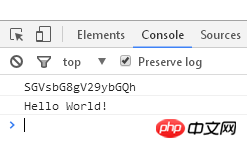Home >Web Front-end >JS Tutorial >How to encrypt and decrypt base64
How to encrypt and decrypt base64
- php中世界最好的语言Original
- 2018-06-07 13:58:223768browse
This time I will show you how to encrypt and decrypt base64, and what are the precautions for base64 encryption and decryption. The following is a practical case, let's take a look.
<!DOCTYPE html>
<html>
<head>
<meta charset="utf-8" />
<title>js base64加密解密</title>
</head>
<body>
<script>
// 创建Base64对象
var Base64 = {
_keyStr: "ABCDEFGHIJKLMNOPQRSTUVWXYZabcdefghijklmnopqrstuvwxyz0123456789+/=",
encode: function(e) {
var t = "";
var n, r, i, s, o, u, a;
var f = 0;
e = Base64._utf8_encode(e);
while (f < e.length) {
n = e.charCodeAt(f++);
r = e.charCodeAt(f++);
i = e.charCodeAt(f++);
s = n >> 2;
o = (n & 3) << 4 | r >> 4;
u = (r & 15) << 2 | i >> 6;
a = i & 63;
if (isNaN(r)) {
u = a = 64
} else if (isNaN(i)) {
a = 64
}
t = t + this._keyStr.charAt(s) + this._keyStr.charAt(o) + this._keyStr.charAt(u) + this._keyStr.charAt(a)
}
return t
},
decode: function(e) {
var t = "";
var n, r, i;
var s, o, u, a;
var f = 0;
e=e.replace(/[^A-Za-z0-9+/=]/g,"");
while (f < e.length) {
s = this._keyStr.indexOf(e.charAt(f++));
o = this._keyStr.indexOf(e.charAt(f++));
u = this._keyStr.indexOf(e.charAt(f++));
a = this._keyStr.indexOf(e.charAt(f++));
n = s << 2 | o >> 4;
r = (o & 15) << 4 | u >> 2;
i = (u & 3) << 6 | a;
t = t + String.fromCharCode(n);
if (u != 64) {
t = t + String.fromCharCode(r)
}
if (a != 64) {
t = t + String.fromCharCode(i)
}
}
t = Base64._utf8_decode(t);
return t
},
_utf8_encode: function(e) {
e = e.replace(/rn/g, "n");
var t = "";
for (var n = 0; n < e.length; n++) {
var r = e.charCodeAt(n);
if (r < 128) {
t += String.fromCharCode(r)
} else if (r > 127 && r < 2048) {
t += String.fromCharCode(r >> 6 | 192);
t += String.fromCharCode(r & 63 | 128)
} else {
t += String.fromCharCode(r >> 12 | 224);
t += String.fromCharCode(r >> 6 & 63 | 128);
t += String.fromCharCode(r & 63 | 128)
}
}
return t
},
_utf8_decode: function(e) {
var t = "";
var n = 0;
var r = c1 = c2 = 0;
while (n < e.length) {
r = e.charCodeAt(n);
if (r < 128) {
t += String.fromCharCode(r);
n++
} else if (r > 191 && r < 224) {
c2 = e.charCodeAt(n + 1);
t += String.fromCharCode((r & 31) << 6 | c2 & 63);
n += 2
} else {
c2 = e.charCodeAt(n + 1);
c3 = e.charCodeAt(n + 2);
t += String.fromCharCode((r & 15) << 12 | (c2 & 63) << 6 | c3 & 63);
n += 3
}
}
return t
}
}
// 定义字符串
var string = 'Hello World!';
// 加密
var encodedString = Base64.encode(string);
console.log(encodedString); // 输出: "SGVsbG8gV29ybGQh"
// 解密
var decodedString = Base64.decode(encodedString);
console.log(decodedString); // 输出: "Hello World!"
</script>
</body>
</html>
Run results:

I believe you have mastered the method after reading the case in this article. For more exciting information, please pay attention to other related articles on the php Chinese website!
Recommended reading:
JS implementation of gray text prompts in the input box
The above is the detailed content of How to encrypt and decrypt base64. For more information, please follow other related articles on the PHP Chinese website!
Statement:
The content of this article is voluntarily contributed by netizens, and the copyright belongs to the original author. This site does not assume corresponding legal responsibility. If you find any content suspected of plagiarism or infringement, please contact admin@php.cn
Previous article:How to dynamically bind images and return image paths from data in vueNext article:How to dynamically bind images and return image paths from data in vue
Related articles
See more- An in-depth analysis of the Bootstrap list group component
- Detailed explanation of JavaScript function currying
- Complete example of JS password generation and strength detection (with demo source code download)
- Angularjs integrates WeChat UI (weui)
- How to quickly switch between Traditional Chinese and Simplified Chinese with JavaScript and the trick for websites to support switching between Simplified and Traditional Chinese_javascript skills

